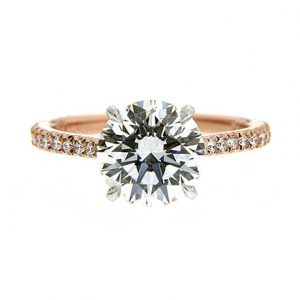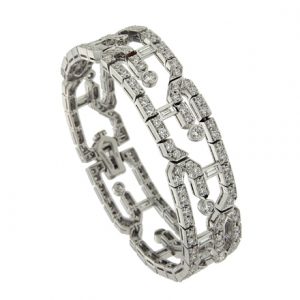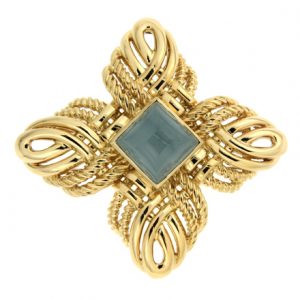Gold
Gold is a precious metal with many special qualities. It is soft, making it easy to chase, draw, polish, hammer, engrave or otherwise bend to a designer’s wishes. At the same time, it withstands heat, oxidization and damage from most chemicals. In addition to its malleability and durability, it has a strong luster and a deep yellow color long prized for its beauty.
Pure gold is rated 2.5 on the Mohs Scale of Mineral Hardness. While this is useful for crafting jewelry, once the piece is completed, pure gold is vulnerable to dents scratches and other damage impacting the shape of the jewelry. To add strength, it’s mixed with other metals. The purity of metal alloys is measured in karats, with 24 karat gold containing over 99% gold.
A wide variety of metals are blended with gold, including silver, copper, palladium and others. Depending on the type and quantity of material used, gold may change color. The most popular alloys are white gold, rose gold, and blends that retain gold’s yellow hue. Less common but still utilized mixes include green gold, blackened gold and alloys that resemble wood grain.
Rose Gold
Rose Gold Jewelry

Rose gold is made by combining copper and gold. Depending on how much copper is added to the alloy, the reddish tones of the gold may range from a subtle blush to strong red overtones. Other materials, like zinc or silver, may be added to play with color even further, emphasizing pink over red, or bringing out a deep yellow undertone.
The warm tones of rose gold have risen in and out of popularity over the years, depending on what colors and designs are in vogue. Rose gold lends itself well to bi- and tricolored pieces, its blush standing out against other gold blends. It also pairs well with pink gemstones like sapphires and tourmaline, and provides a counterpoint to cooler jewelry like diamond engagement rings.
White Gold
White Gold Jewelry

White gold can be made from a number of recipes. Gold may be blended with zinc, platinum, nickel or copper in a variety of ratios. In the United States, 14K white gold is made of 583 parts pure gold to 417 other materials, and 18K is 750 parts gold to 250 other. Depending on the manufacturer, it may even be dipped in rhodium for a bright finish.
As with other colored gold, variations to the recipe leads to subtle differences in the finished alloy. Nickel may be used to lighten gold, though it’s fallen out of favor. Palladium mixed with gold is more popular, accommodating people with skin sensitivities. Adding copper to the blend adds malleability to the gold, making it easier to work with, but can add a reddish tinge. Zinc may be used to help tone down the copper.
For people who enjoy the sheen of platinum, but are on a budget, white gold is an affordable alternative. White gold is also ideal for those who enjoy the appearance of silver, but prefer a metal that doesn’t tarnish. Due to its cool coloring, white gold pairs well with diamond bands. When choosing a diamond to set with the precious metal, look for a jewel with a good color rating. Any brown or yellow tint may be highlighted otherwise.
White gold is also a good choice for people who want a vintage style diamond engagement ring. Many jewelry designs of the early 20th century combine the brilliance of diamonds with the luster of white toned metal. Combining white gold with diamond bands is one way to emulate designs of the past.
Yellow Gold
Yellow Gold Jewelry

Yellow is gold’s natural color, and one of the most common hues for gold jewelry. Its use is ancient, with artifacts dating to around 4400 B.C.E. in predynastic Egypt. Depending on the period and culture, yellow gold with a very high karat grade may be used. Other times and locations prefer to blend lower ratios of gold with other materials to give it strength, while maintaining its yellow hue.
To add durability, gold may be mixed with copper, silver, nickel, zinc and other materials. Many of these metals are also used to give gold other tints, such as copper for rose gold and silver for green. For this reason, the jeweler must be careful with measurements and how much of what metals to add to the gold. Other factors to consider is how comfortable an alloy would feel against the skin, as well as what recipe will suit the eventual jewelry design. Depending on the creation, the jeweler may want more hardness, greater ductility, or other traits.
Cultural differences may lead connoisseurs to seek yellow gold jewelry with a very high karat grade. In Sri Lanka for example, 22K gold pieces are popular as a form of investment as well as ornamentation. Jewelry with a high karat number is often made for weddings and other special occasions in mind, and may be adorned with auspicious symbols. While their high percentage of gold adds value to the pieces, it also makes them fragile. The wearer has to be mindful of how they move lest they dent or otherwise damage the jewelry.
Yellow gold is a timeless choice for precious metal jewelry. Engagement rings, wedding bands and other tokens of love have been made from gold since at least the Roman Empire. Embellishment and styles have changed over the centuries, such as Mary of Burgundy’s 1477 diamond engagement ring, solitaire diamond wedding bands of the 20th century, or gold wedding bands of the 17th century, engraved with heartfelt messages. Choosing this precious metal for your ring will connect you with the many romances of past and present.
Green Gold
Blending gold with platinum, palladium and other white metals usually creates white gold. When gold mixes with silver, the result is green. Greenish gold has been used since ancient Egypt, when silver-gold alloys were used to decorate pyramids and other monuments. Modern green gold is often made from 75% gold and 25% silver, though copper or zinc may also be included.
Naturally occurring silver-gold mixes are known as electrum. This alloy dates back to antiquity, with mentions in the Odyssey. Civilizations around the Mediterranean used electrum for decorative purposes as well as for currency. With silver adding strength to the gold, electrum coins were preferred over pure gold for coins.
Green gold is most commonly found in designs that use multiple gold alloys. Bicolor gold, tricolor gold and gold à quatre couleurs jewelry frequently use gold of different colors to create stripes, geometric patterns and other designs to create a study in contrast. In these pieces, green gold is commonly combined with rose, white or yellow gold.
Blackened Gold
There is no specific alloy that turns gold from yellow to black. In order to give gold this color, it may be subject to one of several surface treatments. One possibility is electroplating, affixing black rhodium or ruthenium to the gold. Plasma may be used in conjunction with chemical vapor deposition to place amorphous carbon on gold, or a patina containing oxygen and sulfur may be applied instead. If the gold is alloyed with 25% cobalt or chromium, the gold may be oxidized in order to blacken.
Blackened gold may be used by those looking for an avant-garde style for their diamond wedding band or engagement rings. The dark coloring can serve as a contrast to the light tone and brilliance of diamonds. Blackened gold may also be paired with darker jewels for a striking visual effect. It may also serve as one of the hues in tricolor gold, helping to draw the eye towards the jewels in a diamond engagement ring.





